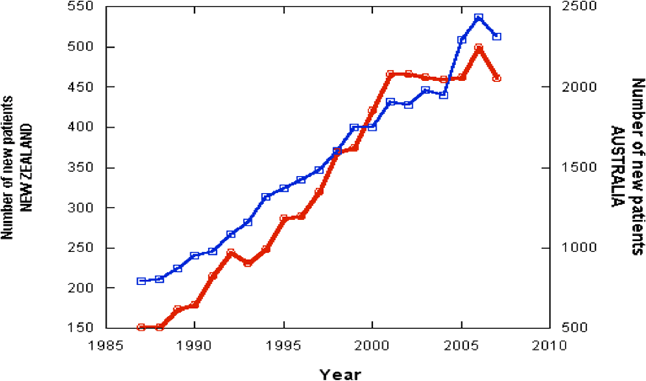Aims
The scale of the problem of renal disease - frequently called the ‘silent killer’ because of its gradual and insidious onset - is shown starkly by the graph below. It shows the number of new patients each year undergoing renal replacement therapy (RRT), either dialysis or renal transplantation, in New Zealand and Australia from 1987-2007.

The number of new patients receiving RRT (dialysis or renal transplantation) in New Zealand (red) and Australia (blue) between 1987 and 2007. Data from ANZDATA report 2008.
The number reaching end stage renal disease has shown an exponential increase over this period. Both American and Australian data suggest that as many as one in seven of their respective populations is at risk of developing chronic kidney disease (CKD). In New Zealand, almost half (203 out of 461) of those treated by RRT in 2007 were Māori and Pacific Islanders.
Recent evidence from epidemiological studies has identified that 1 in 7 Australians have deteriorating kidney function, primarily the result of the increased incidence of diabetes and hypertension, and which has translated into increasing numbers entering dialysis programs. Large epidemiological studies have further identified increased risk of kidney failure in those with age greater than 50, those who smoke, are persons of indigenous descent or have a familial history of renal disease and/or diabetes.
In New Zealand, similarly, there is an epidemic of type 2 diabetes mellitus which will have major implications for the limited health resources of this country. Obesity and other lifestyle factors are significant contributing influences. Nearly 50% of patients starting dialysis have kidneys damaged by diabetes. Early diagnosis can substantially affect outcomes, and timely intervention can greatly mitigate renal deterioration or extend the functional life of the kidneys, as well as reducing cardiovascular risk, offering material improvement to the quality of life. There is therefore a premium on understanding mechanisms of insult to the kidney, so as to allow earlier detection and better treatment.
In addition, the kidney and heart are integral in terms of haemodyanmics and regulatory functions. The kidney plays a central role in electrolyte balance, volume and blood pressure regulation, all of which are substantially modified in chronic kidney disease (CKD). Thus, patients with CKD have in addition a 3- to 5-fold higher risk of cardiovascular events and diabetic sufferers with CKD have up to a 20-fold higher risk of early death. The close link with cardiovascular risk factors to morbidity and mortality, places renal disease, diabetes and cardiovascular disease into an interactive spectrum of metabolic disease. This is the overall focus of the research undertaken by this group.
The University of Otago Research Network is the only group of researchers in New Zealand carrying out studies of renal disease from 'bench to bedside' from molecular studies of renal development, through laboratory studies of renal physiology and pathophysiology, to clinical investigations. Innovative medical research thrives on the cross-fertilisation of ideas between scientists and clinicians from diverse backgrounds but common interests.
This is an established aspect of our collaborative programme. Our network has already facilitated a great deal of research in overlapping areas of interest locally and nationally. In addition, we have established a number of international collaborations which create another dimension to the research potential. Many joint research grants and joint publications are already in existence. These and ongoing programmes are described on this website.
The research strands of this research theme are strongly interwoven:
- Clinical nephrology (Rob Walker, John Shollum, Suetonia Palmer, Mark Marshall, Zoltan Endre)
- Exercise physiology and body volume (Rob Walker, Jim Cotter)
- Diabetes (Rob Walker, Patrick Manning, Chris Baldi)
- Renocardio medicine (Rob Walker, Chris Baldi, Gerry Wilkins)
- Developmental nephrology and biology (Mike Eccles, Cherie Stayner, Alan Davidson)
- Basic physiology (Fiona McDonald, Martin Fronius, Jennifer Bedford, John Leader)
- Pharmaceutical nephrology (Stephen Duffull, John Schollum)
- Biomarkers for renal function (Zoltan Endre, Alex McLellan)
- Renal pharmacology (Ivan Sammutt).
There are also strong collaborations within New Zealand: Professors Tony Merriman, Stephen Duffull and Alex McLellan. In Australia: Professors Glenda Gobe, Richard Kitching and David Harris; In Norway, Professor Hans Peter Marti, in England, Professor Richard Coward, in The Netherlands, Professor Peter Deen, and In the United States, Professors Jeff Sands and David Weiner.
These interests lead outwards into the wider academic community, to those patients and volunteers involved in clinical trials, and to the general public.
All members of the group meet up to four times a year for a half or full day of research seminars. They also meet regularly in smaller groups as required by particular projects. The Theme has a Journal Club which meets weekly to review current literature.
We will expand our collaborative Network for Kidney Research, linking an understanding of the molecular and cellular physiology of kidney function to the clinical application of therapies that prevent kidney injury or the progression of kidney disease.
Our specific long term objectives are to:
- Elucidate key mechanisms of renal epithelial and endothelial cell damage following injury by different agents or mediators
- Elucidate the genetic and cellular processes that lead to irreversible fibrosis or repair
- Define new targets for intervention in the pathways leading to cell injury and death.
This knowledge will lead to more focused interventions that will reduce the rapidly increasing incidence of chronic kidney disease and the need for renal replacement therapy (dialysis and transplantation).
